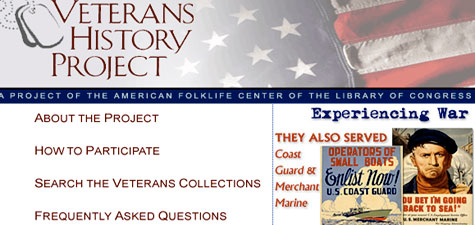BROWSE BY CATEGORY
- Archives and Libraries
- Blogs and Networking
- Bookmark This
- Digital Tools
- Examples of Teaching
- Exhibits
- Film Reviews
- History and Headlines
- Historic Sites and Museums
- Historical Thinking
- Holidays and Heritage
- Issues and Research
- Lesson Plans
- Material and Visual Culture
- Multimedia
- Organizations and Agencies
- Primary Sources
- Professional Development
- Publications
- Student Activities
- Teaching Materials
- Websites
Veterans, Oral History, and the Library of Congress

An oral history project with veterans is a great way to involve students in family, community, national, and global history. And it's a useful methodology for teaching how to work with historical evidence.
Far more than simple question and answer sessions, oral history is actually a systematized, disciplined effort to record, preserve, and interpret memories of historical significance. It helps students find out about the past, and encourages them to ask critical questions about who tells the story and how it's told. Good oral history projects require research into primary and secondary sources; they exercise planning and interpretive skills; and they ask students to unite mega and micro narratives. Kindergarten pupils can do it, and so can AP history students with learner-appropriate requirements for exercising historical thinking skills—it's an activity adaptable across the curriculum and across grade levels.
The Library of Congress helps bring oral history into the curriculum through the Veterans History Project (VHP), a massive and accessible example of the power of personal narrative. Created in 2000, the VHP collects and preserves the remembrances of American war veterans and civilian workers who supported them from World War I through today's Afghanistan and Iraq conflicts. These collections of firsthand accounts are archived in the American Folklife Center at the Library of Congress.
Not all collections are digitized, but photos, documents, artifacts, and video or audio-recorded interviews (with transcripts) accompany each individual story that is online. Listen to a 50-minute interview and view 39 photographs from Corporal Frank Aceves, a Vietnam War veteran; visit the section Women at War to hear from the first woman Brigadier General in the U.S. Air Force; or check out stories from Buffalo Soldiers, members of only a handful of African American units allowed to serve in combat during World War II.
The Veterans History Project encourages high school students to consider adding to their archives, and they provide specific, detailed information about how to do so from planning through submission.
If you're thinking about developing materials in your own classroom to submit to the Library of Congress Veterans History Project, follow the Wiki Know-How Guide from Eastern Lebanon County High School. This wiki includes step-by-step directions and student work pages as well as examples of students' final projects.
In 2009, the History Channel, together with the Veterans History Project hosted a National Teach-in on Veterans History. The archived hour-long broadcast from the Library of Congress is available online.
The History Channel encourages students and teachers to engage with veterans through Take a Veteran to School Day and the project comes complete with Teacher Resources, from setting up the project to asking questions to sending follow-up thank you notes.
Take a Veteran to School Day is for all grade levels. The online video resources about Veterans Day are most useful from upper elementary through high school, and their materials also include PDFs of primary sources, how-to-do oral histories, and Spanish-language guides.
Making Sense of Oral History in the Clearinghouse under Best Practices is an excellent guide with examples for teachers and for advanced history students about how to create and interpret oral history interviews.